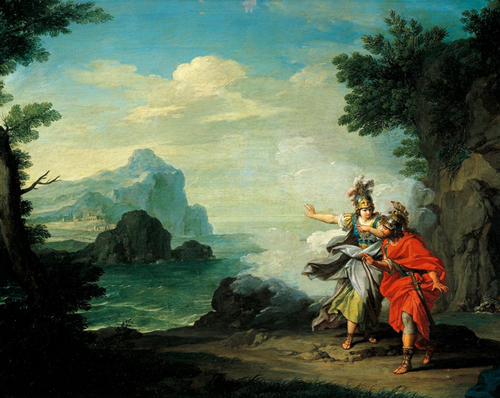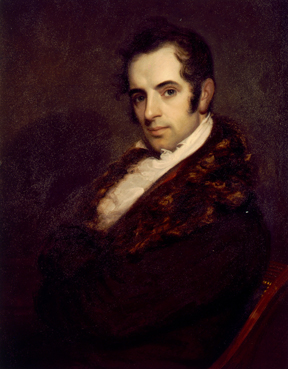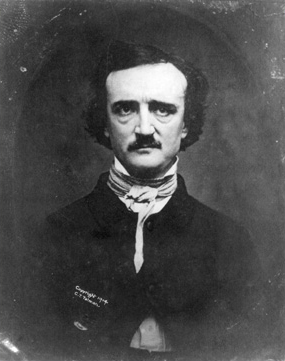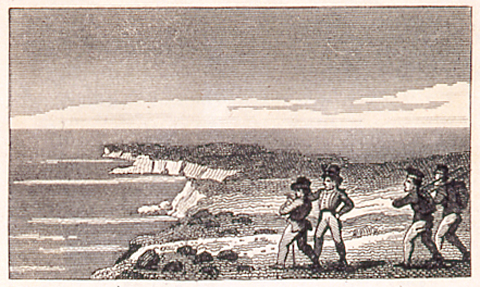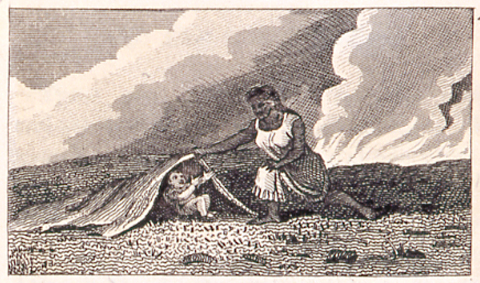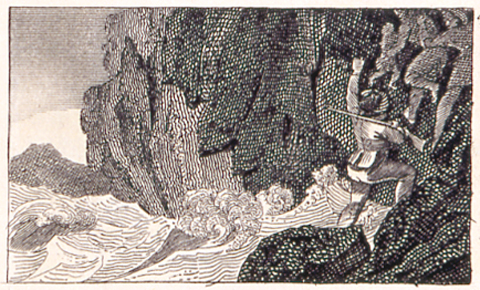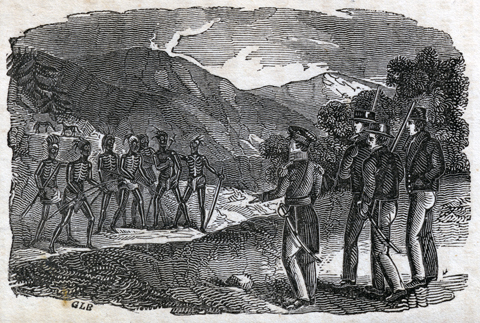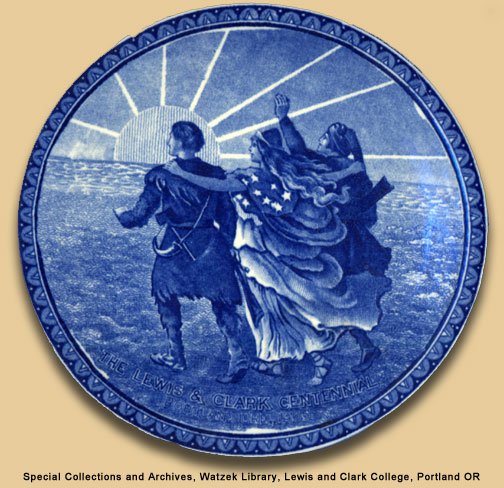In the twenty-first century American West, Lewis and Clark have become cliché, synonymous with exploration and adventure in the same way the term “odyssey” from Homer’s great epic became common usage in the English language. In fact, many have argued that Lewis and Clark is the American epic.
Athena Revealing Ithaca to Ulysses
Guiseppe Bottani (1717–1784)
Oil on canvas, 18.5 x 28.3 in. Courtesy the Bridgeman Art Library.
Compare this with the 1904 World’s Fair Seal (below) where Liberty escorts Lewis and Clark to the western verge of America.
Kristopher K. Townsend, ed.
As early as 1807 Joel Barlow added Meriwether Lewis to his list of explorers who had contributed to an American epic, comparing “the same soaring genius of thy Lewis” to that of Columbus, the central figure in his Homeric epic, The Columbiad.[1]Joel Barlow, “On the Discoveries of Captain Lewis,” The American Register 1 (1807). More recently scholars such as Albert Furtwangler and Clay Jenkinson have described the ways in which the Lewis and Clark Expedition matches the criteria for a Homeric epic.[2]See Albert Furtwangler, Acts of Discovery: Visions of America in the Lewis and Clark Journals (Urbana: University of Illinois Press, 1993); and the transcription for “The Journals of Lewis and … Continue reading Regardless of these literary arguments, the linkage between Lewis and Clark and the term epic is ubiquitous in the American vernacular. The subtitle of Gary Moulton’s one-volume abridgment of his 13-volume edition of the Lewis and Clark journals reads The Lewis and Clark Journals: An American Epic of Discovery (2003). The key overview of the expedition on this website, “The Story” by Harry Fritz, also conjoins the two terms. The continual marriage of these two terms leaves little doubt that Lewis and Clark have become an integral part of Western American mythology and identity.
This development, however, did not occur overnight. There was a time after Meriwether Lewis had committed suicide when William Clark had retired from public service and Jacksonian political ideals had replaced Jefferson’s that Lewis and Clark were afterthoughts in the minds of Americans. It would be easy to assume that Lewis and Clark’s return to prominence is proof of the power of the Expedition narrative, but this is only a small piece of the story. Another reason for Lewis and Clark’s continuing popularity in the twenty-first century may be traced to references to the expedition in nineteenth century literature, the re-discovery of Lewis & Clark in these very publications by later American authors, and the stimulation of interest in reading and teaching that brought fictionalized versions of the Lewis & Clark story to generations of young readers.
Lewis and Clark’s influence was not limited to naturalists. The most popular nineteenth century writers of fiction about the American frontier, Washington Irving and James Fenimore Cooper, were clearly inspired by the explorers’ writings.
Washington Irving
The first of these authors, Washington Irving (1783-1859), brought the West to life with his accounts of a dramatic and adventurous landscape. Already known to the world as the author of The Legend of Sleepy Hollow, Irving returned to America after seventeen years in Europe and undertook a three-month journey into the American frontier. Irving’s first stop was in St. Louis where he met with William Clark, who helped Irving procure supplies and transport through present-day Missouri, Kansas, Oklahoma, and Arkansas. One can only speculate on the conversations between Irving and Clark, but two things are clear: Irving was captivated by the American West, and he repeatedly returned to Lewis and Clark’s journals as inspiration for descriptions of western locales beyond his own experiences.
After returning from the West, Irving penned his first attempt to capture the spirit of the West, A Tour of the Prairies (1835). Irving followed this personal tale with a more ambitious history of the fur trade, Astoria (1836), which recounts John Jacob Astor’s attempt to establish a commercial empire in the Pacific Northwest. In his introduction to the book Irving writes about the genesis of the project:
About two years ago, not long after my return from a tour upon the prairies of the far West, I had a conversation with my friend, Mr. John Jacob Astor, relative to that portion of our country, and to the adventurous traders to Santa Fe and the Columbia. This led him to advert to a great enterprise set on foot and conducted by him, between twenty and thirty years since, having for its object to carry the fur trade across the Rocky Mountains, and to sweep the shores of the Pacific.
Finding that I took an interest in the subject, he expressed a regret that the true nature and extent of his enterprise and its national character and importance had never been understood, and a wish that I would undertake to give an account of it. The suggestion struck upon the chord of early associations already vibrating in my mind. It occurred to me that a work of this kind might comprise a variety of those curious details, so interesting to me, illustrative of the fur trade; of its remote and adventurous enterprises, and of the various people, and tribes, and castes, and characters, civilized and savage, affected by its operations. The journals, and letters, also, of the adventurers by sea and land employed by Mr. Astor in his comprehensive project, might throw light upon portions of our country quite out of the track of ordinary travel, and as yet but little known. I therefore felt disposed to undertake the task.
Utilizing his nephew Pierre’s researches, his relationship with Astor, and the journals of other western explorers, Irving crafted a compelling narrative to describe the early western movements of the Pacific Fur Company. He noted in the introduction, “I have . . . availed myself occasionally of collateral lights supplied by the published journals of other travellers who have visited the scenes described: such as Messrs. Lewis and Clarke.” While Irving carefully disguised his uses of other such journals, it is likely that his ability to transform the experience of the Astorians into an adventure in a majestic new landscape is partly derived from the narrative structure of Lewis and Clark’s journals, and their depictions of nature.
Just one year after the publication of Astoria Irving completed another western historical adventure tale, The Adventures of Captain Bonneville. Irving had met Benjamin Bonneville while doing research at Astor’s, and subsequently purchased Bonneville’s notes and maps of his explorations for $1,000.[3]Brian Jay Jones, Washington Irving: An American Original (New York: Arcade, 2008). Irving never referenced Lewis and Clark, but it is clear that he relied heavily on Biddle’s narrative of the Corps of Discovery in crafting the place names, geographic locations, and cultural features of the native peoples in the western part of North America.
More than any other author of the nineteenth century, Irving captured the landscape of the American West in ink. It is no coincidence that Irving is generally regarded as the first great American author, and that he was the first American to make a living solely as an author. American readers craved Irving’s American West, and working from the examples provided by Lewis and Clark, Irving opened up the west with pen and ink.
James Fenimore Cooper
Unlike Washington Irving, James Fenimore Cooper (1789-1851) never traveled west of Buffalo, New York, yet he managed to write best-selling and compelling books like The Prairie (1827) that were set west of the Mississippi. Like Irving, Cooper turned to Lewis and Clark’s journals for the inspiration and specifics that brought life to his landscapes.
In “The Sources of The Prairie,” E. Soteris Muszynska-Wallace notes that Cooper gathered information from Lewis and Clark to craft his narrative. For example, Cooper’s Weucha was the Indian name for the Bois Brulé Sioux leader who spoke at a council with Lewis and Clark on 31 August 1804, and was described in detail in John Ordway‘s journal.[4]E. Soteris Muszynska-Wallace, “The Sources of The Prairie,“ American Literature, Vol. 21, No. 2 (May 1949), 195. Also, Cooper introduced the story of a boy hiding under a buffalo skin to escape a prairie fire, which, though somewhat embellished, was borrowed directly from Lewis and Clark.[5]Ibid., 196. The Prairie, by James Fenimore Cooper, chap. 24. History of the Expedition. 2 vols. (Philadelphia: Bradford and Inskeep, 1814), vol. 2, 29 October 1804; Moulton, Journals, 30 October 1804 … Continue reading Finally, to add authenticity to his descriptions of the Indians, Cooper borrowed information on the construction of bull boats from Lewis and Clark.[6]Ibid., 199. The Prairie, chap. 24. Allen, History of the Expedition, 2:400 (8 August 1806). 9 October 1804; Moulton, Journals, 27 June 1805 (Ordway). Like Irving, Cooper saw a distinctive vision of the West framed by the words of Lewis and Clark, which he translated into popular fiction. Pioneers of Western literature, Irving and Cooper codified Lewis and Clark’s American West in fiction, while inspiring a new generation of writers, including the transcendentalists.[7]See Kris Fresonke, West of Emerson: The Design of Manifest Destiny (Berkeley: University of California Press, 2003).
Edgar Allan Poe
Though he was not cut from the same literary cloth as Irving and Cooper, the powerful narrative of Lewis and Clark did not escape the attention of America’s first great writer of suspense, Edgar Allan Poe (1809-1849). Although it is rarely mentioned as one of Poe’s great works, his serialized “Journal of Julius Rodman” (1840) was lifted directly from the pages of Lewis and Clark. While such a story may seem uncharacteristic for Poe, the publication begins to make sense if we keep in mind that Irving and Cooper had already established the popularity of Lewis and Clark’s west in fiction. Additionally, by 1840 larger numbers of Americans were beginning to migrate to regions west of the Rockies. Poe certainly knew he could easily capitalize on these circumstances.
The serialized chapters from the journal of a “Julius Rodman” first appeared in Burton’s Gentlemen’s Magazine of January 1840, and continued to appear for six months, until June 1840 when they came to an abrupt stop. The journal purported to detail a 1792 expedition led by Julius Rodman up the Missouri River toward the Northwest. This 1792 expedition would have made Rodman the first European to cross the Rocky Mountains.
Rodman, though, was a fictitious character invented by Poe. To create this deception, Poe invented the entire journal, relying heavily on Washington Irving’s Astoria and Lewis and Clark’s History of the Expedition to give his account a veneer of authenticity. The story was never completed in the magazine. Although no reason was ever given by Poe or his publisher, most scholars assume that Poe stopped writing because of disputes over payment with the publisher.[8]See Scott Peeples, Edgar Allan Poe Revisited (New York: Twayne, 1998).
In his first installment of “The Journal of Julius Rodman” Poe provides an authentic historical account, presumably to provide a sense of authenticity to his fabrication. He writes:
The memorable expedition of captains Lewis and Clarke was in progress during the years 1804, 1805, and 1806. In 1803, the act for establishing trading houses with the Indian tribes being about to expire, some modifications of it (with an extension of its views to the Indians on the Missouri) were recommended to Congress by a confidential Message from Mr. Jefferson, of 18 January 1803. In order to prepare the way, it was proposed to send a party to trace the Missouri to its source, cross the Rocky Mountains, and follow the best water communication which offered itself thence to the Pacific ocean. This design was fully carried out; captain Lewis exploring (but not first “discovering” as Mr. Irving relates) the upper waters of the Columbia river, and following the course of that stream to its embouchure. The head waters of the Columbia were visited by Alexander Mackenzie as early as 1793.[9]Edgar Allan Poe, “The Journal of Julius Rodman,” Burton’s Gentlemen’s Magazine (January 1840), Chapter 1, page 5.
As he begins the main part of his story, Poe borrows from the journals of Lewis and Clark to craft a story that incorporates similar people, places, and species into his narrative. As Clark had York, Rodman had a Negro slave named Toby. Poe writes:
Our other two recruits were a negro belonging to Pierre JunÙt, named Toby, and a stranger whom we had picked up in the woods near Mills’ Point, and who joined our expedition upon the instant as soon as we mentioned our design. His name was Andrew Thornton, also a Virginian, and I believe of excellent family, belonging to the Thorntons of the northern part of the State. He had been from Virginia about three years; during the whole of which time he had been rambling about the western country, with no other companion than a large dog of the Newfoundland species. He had collected no peltries, and did not seem to have any object in view, more than the gratification of a roving and adventurous propensity.
Poe’s allusion to Lewis’s Newfoundland dog, Seaman, is a bit confusing, since the only known mention of Lewis’s dog being a Newfoundland is in his Ohio River journal entry of 16 November 1803, which was unpublished until 1916, well after Poe’s death.[10]Milo Milton Quaife, The Journals of Captain Meriwether Lewis and Sergeant John Ordway (Madison: [Wisconsin Historical] Society, 1916), 48. This would appear to indicate that stories of Lewis’s dog were a part of the common folklore associated with the Expedition.
Like the Lewis and Clark Expedition, the Rodman expedition also had a keelboat, which Poe describes as:
The other was a keelboat which we had made at Petite CÙte (the canoe having been purchased by Pierre from the Mississippi party.) It was thirty feet long, and, when loaded to the gunwale, drew two feet water. it had a deck for twenty feet of its length forward, forming a cuddy-cabin, with a strong door, and of sufficient dimensions to contain our whole party with close crowding, as the boat was very broad. This part of it was bulletproof, being wadded with oakum between two coatings of oak-plank; and in several positions we had small holes bored, through which we could have fired upon an enemy in case of attack, as well as observe their movements; these holes, at the same time, gave us air and light, when we closed the door; and we had secure plugs to fit them when necessary.[11]Edgar Allan Poe, “The Journal of Julius Rodman” Burton’s Gentlemen’s Magazine (January 1840), Chapter 2, page 3.
While other authors including Irving and Cooper had borrowed characters and implements, Poe went so far as to borrow the most distinct natural setting described by Lewis and Clark, the White Cliffs of the Missouri. Poe writes:
The face of these remarkable cliffs, as might be supposed, is chequered with a variety of lines formed by the trickling of the rains upon the soft material, so that a fertile fancy might easily imagine them to be gigantic monuments reared by human art, and carved over with hieroglyphical devices. Sometimes there are complete niches (like those we see for statues in common temples) formed by the dropping out bodily of large fragments of the sandstone; and there are several points where staircases and long corridors appear, as accidental fractures in the freestone cornice happen to let the rain trickle down uniformly upon the softer material below. We passed these singular bluffs in a bright moonlight and their effect upon my imagination I shall never forget. They had all the air of enchanted structures, (such as I have dreamed of,) and the twittering of myriads of martins, which have built their nests in the holes that every where perforate the mass.[12]Ibid., Chapter 6, pages 2-3.
The defining moment of Poe’s Rodman piece was his explanation of the American grizzly bear, where he employed notions of suspense, danger, intrigue, and the macabre to write of the ferocity, majesty, and sheer power of the bear. Poe borrowed elements from Lewis and Clark’s descriptions of encounters with grizzlies on May 5, 11, and 14 of 1805 (see Grizzly Bear Encounters).
We had scarcely time to say a word to each other before two enormous brown bears (the first we had yet encountered during the voyage) came rushing at us open-mouthed from a clump of rose-bushes. These animals are much dreaded by the Indians, and with reason, for they are indeed formidable creatures, possessing prodigious strength, with untamable ferocity, and the most wonderful tenacity of life. There is scarcely any way of killing them by a bullet, unless the shot be through the brains, and these are defended by two large muscles covering the side of the forehead, as well as by a projection of thick frontal bone. They have been known to live for days with half a dozen balls through the lungs, and even with very severe injuries in the heart. So far we had never met with a brown bear, although often with its tracks in the mud or sand, and these we had seen nearly a foot in length, exclusive of the claws, and full eight inches in width.
What to do was now the question. To stand and fight, with such weapons as we possessed, was madness; and it was folly to think of escape by flight in the direction of the prairie; for not only were the bears running towards us from that quarter, but, at a very short distance back from the cliffs, the underwood of briar-bushes, dwarf willow, etc., was so thick that we could not have made our way through it at all, and if we kept our course along the river between the underwood and the top of the cliff, the animals would catch us in an instant; for as the ground was boggy we could make no progress upon it, while the large flat foot of the bear would enable him to travel with ease. It seemed as if these reflections (which it takes some time to embody in words) flashed all of them through the minds of all of us in an instant—for every man sprang at once to the cliffs, without sufficiently thinking of the hazard that lay there. . . .
This was the first time in all my life I had ever been brought to close quarters with a wild animal of any strength or ferocity, and I have no scruple to acknowledge that my nerves were completely unstrung. For some moments I felt as if about to swoon, but a loud scream from Greely, who had been seized by the foremost bear, had the effect of arousing me to exertion, and when once fairly aroused I experienced a kind of wild and savage pleasure form the conflict.
One of the beasts, upon reaching the narrow ledge where we stood, had made an immediate rush at Greely, and had borne him to the earth, where he stood over him, holding him with his huge teeth lodged in the breast of his overcoat—which, by greatest good fortune, he had worn, the wind being chilly. The other, rolling rather than scrambling down the cliff, was under so much headway when he reached our station that he could not stop himself until the one-half of his body hung over the precipice; he staggered in a sidelong manner, and his right legs went over while held on in an awkward way with his two left. While thus situated he seized Wormley by the heel with his mouth, and for an instant I feared the worse, for in his efforts to free himself from the grasp the terrified struggler aided the gear to regain his footing. While I stood helpless, as above described, through terror, and watching the event without ability to render the slightest aid, the shoe and moccasin of W. were torn off in the grasp of the animal, who now tumbled headlong down to the next terrace, but stopped himself, by means of his huge claws, from sliding farther. It was now that Greely screamed for aid, and the Prophet and myself rushed to his assistance. We both fired our pistols at the bear’s head; and my own ball, I am sure, must have gone through some portion of his skull, for I held the weapon close to his hear. He seemed more angry, however, than hurt; the only good effect of the discharge was in his quitting his hold of Greely (who had sustained no injury) and making at us. We had nothing but our knives to depend upon, and even the refuge of the terrace below was cut off from us by the presence of another bear there. We had our backs to the cliff, and were preparing for a deadly contest, not dreaming of help from Greely (whom we supposed mortally injured) when we heard a shot, and the huge beast fell at our feat, just when we felt his hot and horribly fetid breath in our faces. Our deliverer, who had fought many a bear in his life-time, had put his pistol deliberately to the eye of the monster, and the contents had entered his brain.[13]Ibid., Chapter 6, pages 5-6.
Children’s Literature
As these examples from his short serialized American western show, Poe was successful at perpetuating both the myths and the sense of adventure that permeates Lewis and Clark’s writings. It is through his pen, as well as that of Irving and Cooper, that the nineteenth century literary world continued to see the West as a place of wildness, romance, danger, and independence.
Naturalists and fiction writers influenced readers in subtle ways. They depicted an American west based on and inspired by Lewis and Clark’s journals, but the authors of juvenile literature wrote explicitly about the Expedition. Although difficult to quantify, it is possible that this literary genre did more than any other to elevate the Expedition in the minds of the public.
The earliest works of juvenile literature about Lewis and Clark were British in origin. The early nineteenth century education system in Britain was more developed than that in the United States, and as a global power its readers were interested in all regions of its empire (or previous empire). While printers in North America issued numerous copies of the New England Primer (a Puritan text first issued around 1690) for the teaching of reading, “For most colonists of European descent, the household remained the most important site for preliminary instruction in how to read,” and there is no doubt that British texts would have remained in use in some of those homes, even well into the nineteenth century.[14]See Hugh Amory and David Hall, eds., The Colonial Book in the Atlantic World (Worcester, Mass., American Antiquarian Society, 2000), 382.
Bingley’s Travels
The first known book of this nature was the Reverend William Bingley’s Travels in North America from Modern Writers With Remarks and Observations; Exhibiting a Connected View of the Geography and Present State of that Quarter of the Globe. (London: Harvey and Darton) published in 1821.[15]Most of the information about juvenile books dealing with Lewis and Clark is based on research by Elaine Gass-Hirsch, librarian at Lewis and Clark College’s Aubrey Watzek Library. This title is the North American volume from a series on world travels presented in daily lessons, which includes descriptions of North American cities such as New York, Philadelphia, Quebec, and Montreal and contains stories of travel within the continent. The Lewis and Clark material included under the section Western Territory of America in three parts, the Fifteenth, Sixteenth and Seventeenth Days’ Instruction. The Fifteenth Day’s Instructionis a narrative of the voyage from St. Louis to the source of the Missouri. The Sixteenth Day’s Instruction begins with the winter at Ft. Mandan and extends to the Expedition’s arrival at the supposed source of the Missouri. The Seventeenth Day’s Instruction covers the journey across the Rocky Mountains to the Pacific and the return to St. Louis. The practice of compressing the second half of the journey into a single chapter has become standard practice, even for academic works about the expedition.
Taylor’s Scenes in America
“Captains Lewis and Clarke at the Pacific Ocean”
from Taylor’s Scenes in America
Special Collections and Archives, Watzek Library, Lewis and Clark College, Portland, Oregon.
17 November 1805: Lewis and several men of the Corps of Discovery explored Cape Disappointment; Clark and a separate party arrived there two days later.
Also published in London in 1821 was Isaac Taylor’s Scenes in America, For the Amusement and Instruction of Little Tarry-at-Home Travellers. Taylor was a major contributor to English children’s literature during the nineteenth century; Scenes in America was reprinted many times and even translated into Dutch. The text covers the travels of explorers such as Columbus, Cortez, Balboa, and Lewis and Clark. The Lewis and Clark information begins under a section entitled North American Indians, and is notable as being the first known account to establish Sacagawea as an individual from the narrative. A poem about Sacagawea, “Meeting of Two Indian Women,” was the first to invoke her name. Taylor’s many copper engravings include twelve Lewis and Clark-related plates associated with numbered passages of text.
29 October 1804:
A boy of the half white breed escaped unhurt in the midst of the flames; his safety was ascribed to the great medicine spirit, who had preserved him on account of his being white. But a much more natural cause was the presence of mind of his mother, who, seeing no hopes of carrying off her son, threw him on the ground, and covering him with the fresh hide of a buffaloe, escaped herself from the flames; as soon as the fire had hassed, she returned and found him untouched, the skin having prevented the flames from reaching the grass on which he lay.
–Biddle (1814)
In the month of May 1804, the two captains started from St. Louis. They took with them twentyseven white men, and a negro who was named York. They went on board three boats. One of them was a large one, with a deck and a cabin. The other two were small open boats.
Bell’s Tales of Travels
Council or Talk with the Indians
from Bell’sTales of Travels West of the Mississippi
Special Collections and Archives, Watzek Library, Lewis and Clark College, Portland, Oregon
The next day, the Captains held a talk with these Indians, and gave them some presents. They behaved very politely. I will tell you a few of their tittles, to show you what strange names they have. There was Crow’s Head, Iron Eyes, Great Blue Eyes, Black Cat, Big Ox, and Brave Man.
In the above, Bell quoted the names from Biddle’s paraphrase (1814) of Clark’s journal for 19 August 1804. Crow’s Head was a Missouria Indian; the rest were Otoes.
The Travellers in Winter Quarters on the Shore of the Pacific Ocean
from Bell’sTales of Travels West of the Mississippi
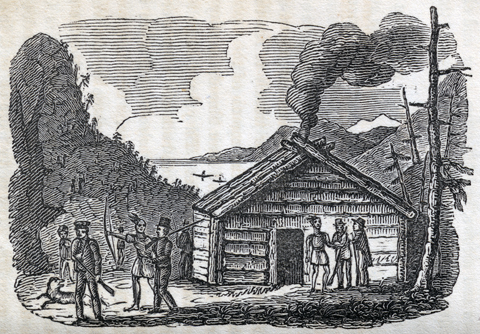
Special Collections and Archives, Watzek Library, Lewis and Clark College, Portland, Oregon
The whole party went to this place; and on the tenth of December they cut down trees, and began to build houses. The spot they had selected was near a very lofty mountain.
Clark estimated that the snowcovered mountain—perhaps Saddle Mountain—was about ten miles southeast of Fort Clatsop. See his journal for 17 December 1805.
The first American juvenile book to include significant material about Lewis and Clark was Solomon Bell’s (William Snelling) Tales of Travels West of the Mississippi published in Boston by Gray and Bowen in 1830. This work is a volume in a series dealing with geographical voyages that is similar to the travelogue prepared a decade earlier by Isaac Taylor. It adapts the accounts of the Lewis and Clark Expedition, Major Long’s Expedition to the Rocky Mountains and the Arkansas River, and John Jewitt’s captivity by Indians on Vancouver Island. Chapters 2 to 28 of the book recount the Expedition. Clark’s accompanying slave York and Mrs. Chaboneau, a.k.a. Sacagawea, are named in the text, and the book is clearly paternalistic in its treatment of Native Americans.
These early primers were notable not only for their retelling of the Lewis and Clark story in often romantic and terms, but for their attempts to illustrate the Western landscape. Although crude, the illustrations provided readers with images of natural settings and iconic images to assist in remembering the stories.There is little doubt that as these texts were implemented in the growing American school system, Lewis and Clark eventually became ingrained in the minds of American students.
The three books described above are just a sampling of the earliest juvenile books written about the Expedition. By the end of the nineteenth century the American school system had become much more expansive and large numbers of such texts were being produced in the United States.
Frederick Jackson Turner’s Thesis
After the initial publication of government documents related to the expedition and the first-hand accounts published in the early nineteenth century, the American public was re-introduced to Lewis and Clark by nature writers, fiction writers, and reading teachers. By understanding Lewis and Clark’s initial introduction into the corpus of American literature, we can begin to see the ways in which Lewis and Clark became commonplace in the Western American mythology.
Perhaps the true measure of Lewis and Clark’s growing influence by the late nineteenth century can be seen in Frederick Jackson Turner’s frontier thesis, which Turner first introduced in a 12 July 1893 paper read to the American Historical Association during the Chicago World’s Fair. This thesis, which has continued to dominate historical debate in relation to the American West, claimed that a virtuous and independent American character was dependent on the frontier experience and mankind’s interaction with an untamed landscape. While Jackson’s framing of his argument is considered monumental among American historians, his ideas were clearly steeped in his own upbringing, which included primers that romanticized Lewis and Clark’s exploration, fiction that lauded the frontier independence and democracy personified by the Corps of Discovery, and scientific treatises that attempted to capture in time the “untainted” landscape seen by Lewis and Clark.[16]See Ray Allen Billington, Frederick Jackson Turner: Historian, Scholar, Teacher (New York: Oxford, 1973), 383-398. In fact, after the success of his frontier thesis, Turner considered writing a book about the Lewis and Clark Expedition to be published by G. P. Putnam’s. One can only conclude that the defining historical theory of the last one hundred years was in a sense an unconscious coming to terms with the nineteenth century understanding of Lewis and Clark. In his thesis, Turner wrote:
To the frontier the American intellect owes its striking characteristics. That coarseness and strength combined with acuteness and inquisitiveness; that practical, inventive turn of mind, quick to find expedients; that masterful grasp of material things, lacking in the artistic but powerful to effect great ends; that restless, nervous energy; that dominant individualism, working for good and for evil, and withal that buoyancy and exuberance which comes with freedom—these are traits of the frontier, or traits called out elsewhere because of the existence of the frontier.[17]http://nationalhumanitiescenter.org/pds/gilded/empire/text1/turner.pdf
If one were to remove this passage from Turner’s thesis and insert into any twentieth century book on Lewis and Clark, such as Stephen Ambrose’s Undaunted Courage, and replace the word “frontier” with “Corps of Discovery,” the text could serve as an apt summary of the modern perception of the expedition.
Olin Wheeler’s Trail
Ten years after Frederick Jackson Turner’s thesis, one finds even more evidence of the depth to which Lewis and Clark had permeated American thought. The 1904 World’s Fair in Portland was actually titled the “Lewis and Clark Fair.” In this year, Olin Wheeler issued his two volume work (see Wheeler’s “Trail of Lewis and Clark”), which retraced the Lewis and Clark route and encouraged others to do the same (except by train, Wheeler was on the payroll of Northern Pacific Railroad). Thousands followed Wheeler’s advice and visited Portland, where they had the opportunity to purchase the newly published Lewis and Clark journals in their entirety, edited by one of the United States’ leading historians, Reuben Gold Thwaites. In fact the fair was so captivating that thousands actually relocated to the Pacific Northwest, hoping to live out the romance of Lewis and Clark.[18]Carl Abbott, a scholar of the Fair’s history, estimates that it attracted over a million people from outside of Portland, and as a result, Portland alone grew by 184,000 residents between 1900 … Continue reading These settlers, following the Expedition story’s evolution from manuscript to book to fictionalized account, were themselves contributors, perhaps more than their predecessors on the Oregon Trail, to the formation of a Western American epic.
Notes
| ↑1 | Joel Barlow, “On the Discoveries of Captain Lewis,” The American Register 1 (1807). |
|---|---|
| ↑2 | See Albert Furtwangler, Acts of Discovery: Visions of America in the Lewis and Clark Journals (Urbana: University of Illinois Press, 1993); and the transcription for “The Journals of Lewis and Clark—An American Epic?” an episode from the public radio series Unfinished Journey: The Lewis and Clark Expedition (Oregon Public Broadcasting, 2006) www.opb.org/lewisandclark/unfinishedjourney/transcripts/LC111.pdf |
| ↑3 | Brian Jay Jones, Washington Irving: An American Original (New York: Arcade, 2008). |
| ↑4 | E. Soteris Muszynska-Wallace, “The Sources of The Prairie,“ American Literature, Vol. 21, No. 2 (May 1949), 195. |
| ↑5 | Ibid., 196. The Prairie, by James Fenimore Cooper, chap. 24. History of the Expedition. 2 vols. (Philadelphia: Bradford and Inskeep, 1814), vol. 2, 29 October 1804; Moulton, Journals, 30 October 1804 and 31 October 1804 (Ordway). |
| ↑6 | Ibid., 199. The Prairie, chap. 24. Allen, History of the Expedition, 2:400 (8 August 1806). 9 October 1804; Moulton, Journals, 27 June 1805 (Ordway). |
| ↑7 | See Kris Fresonke, West of Emerson: The Design of Manifest Destiny (Berkeley: University of California Press, 2003). |
| ↑8 | See Scott Peeples, Edgar Allan Poe Revisited (New York: Twayne, 1998). |
| ↑9 | Edgar Allan Poe, “The Journal of Julius Rodman,” Burton’s Gentlemen’s Magazine (January 1840), Chapter 1, page 5. |
| ↑10 | Milo Milton Quaife, The Journals of Captain Meriwether Lewis and Sergeant John Ordway (Madison: [Wisconsin Historical] Society, 1916), 48. |
| ↑11 | Edgar Allan Poe, “The Journal of Julius Rodman” Burton’s Gentlemen’s Magazine (January 1840), Chapter 2, page 3. |
| ↑12 | Ibid., Chapter 6, pages 2-3. |
| ↑13 | Ibid., Chapter 6, pages 5-6. |
| ↑14 | See Hugh Amory and David Hall, eds., The Colonial Book in the Atlantic World (Worcester, Mass., American Antiquarian Society, 2000), 382. |
| ↑15 | Most of the information about juvenile books dealing with Lewis and Clark is based on research by Elaine Gass-Hirsch, librarian at Lewis and Clark College’s Aubrey Watzek Library. |
| ↑16 | See Ray Allen Billington, Frederick Jackson Turner: Historian, Scholar, Teacher (New York: Oxford, 1973), 383-398. |
| ↑17 | http://nationalhumanitiescenter.org/pds/gilded/empire/text1/turner.pdf |
| ↑18 | Carl Abbott, a scholar of the Fair’s history, estimates that it attracted over a million people from outside of Portland, and as a result, Portland alone grew by 184,000 residents between 1900 and 1916. Carl Abbott, The Great Extravaganza: Portland and the Lewis and Clark Exposition (Portland: Oregon Historical Society, 1981). |
Experience the Lewis and Clark Trail
The Lewis and Clark Trail Experience—our sister site at lewisandclark.travel—connects the world to people and places on the Lewis and Clark Trail.
Discover More
- The Lewis and Clark Expedition: Day by Day by Gary E. Moulton (University of Nebraska Press, 2018). The story in prose, 14 May 1804–23 September 1806.
- The Lewis and Clark Journals: An American Epic of Discovery (abridged) by Gary E. Moulton (University of Nebraska Press, 2003). Selected journal excerpts, 14 May 1804–23 September 1806.
- The Lewis and Clark Journals. by Gary E. Moulton (University of Nebraska Press, 1983–2001). The complete story in 13 volumes.
